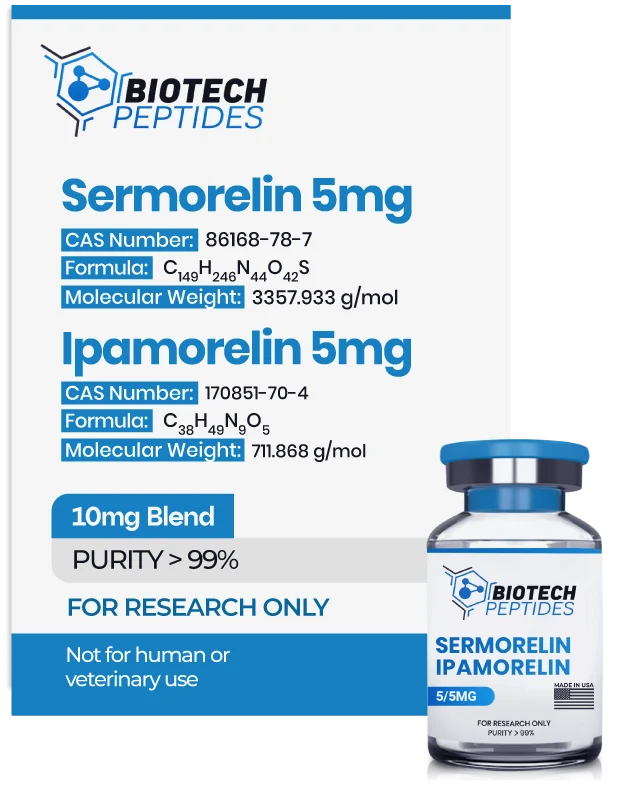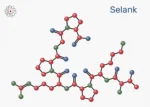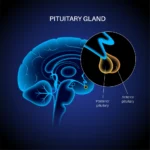Sermorelin is a 29-amino acid peptide fragment[1] derived from the endogenous growth hormone-releasing hormone (GHRH), which appears to represent the biologically active N-terminal portion known as Growth Hormone Releasing Factor (1-29) or GRF (1-29). This truncation from the native 44-amino acid GHRH sequence was reportedly developed to retain receptor affinity while enhancing stability and manufacturability.
Ipamorelin, peptide consisting of five amino acids[2], is reportedly categorized among the growth hormone secretagogues (GHS). Unlike other secretagogues, Ipamorelin appears to exhibit a highly selective agonism for the growth hormone secretagogue receptor subtype 1 alpha (GHS-R1a), minimizing interactions with non-target pituitary hormones such as adrenocorticotropic hormone (ACTH) or prolactin. This suggested selectivity potentially positions Ipamorelin as a peptide with a unique receptor binding profile and pharmacodynamics potential.
When studied in combination, Sermorelin and Ipamorelin may act synergistically due to their differing modes of receptor engagement and signaling pathways. This blend appears to leverage the complementary pathways to potentially maximize growth hormone release, with the potential for improved temporal and amplitude profiles of secretion relative to single-agent exposure. The pharmacokinetic disparity between the peptides, particularly the notably longer half-life of Ipamorelin compared to Sermorelin[3], may further contribute to an extended duration of action.
Mechanism of Action
Studies suggest the mechanisms underlying the activities of Sermorelin and Ipamorelin involve discrete yet interconnected receptor pathways within the pituitary gland.
Sermorelin appears to mimic the endogenous GHRH and binds to the GHRH receptor expressed on somatotroph cells of the anterior pituitary. This binding is hypothesized to induce a cascade of intracellular signaling events culminating in the intermittent release of growth hormone. The episodic secretion pattern is considered critical for physiological regulation, and the subsequent increase in insulin-like growth factor-1 (IGF-1) synthesis is believed to mediate many downstream anabolic and metabolic effects attributed to growth hormone activity.
In contrast, Ipamorelin reportedly functions as a growth hormone secretagogue by engaging the ghrelin receptor pathway. Research suggests that Ipamorelin binds with high affinity and selectivity to the GHS-R1a receptor subtype, which is also localized in the anterior pituitary. This receptor activation is thought to simulate the effects of endogenous ghrelin, the “hunger hormone,” facilitating growth hormone release potentially without significantly influencing other pituitary hormones. This selectivity is particularly notable when compared to other secretagogues that may elicit broader hormonal responses.[5]
The combination of these peptides potentially capitalizes on their distinct receptor interactions. Sermorelin’s GHRH receptor activation is hypothesized to trigger an acute growth hormone release, while Ipamorelin’s engagement with the ghrelin receptor is proposed to sustain and potentiate this response over a longer period. This hypothesis is also supported by their pharmacokinetic profiles, with Sermorelin exhibiting a relatively short half-life of approximately 11 to 12 minutes, contrasted by Ipamorelin’s extended half-life near two hours.[3] Together, these factors suggest that the blend might yield a more robust and temporally prolonged growth hormone secretory effect in research studies than either peptide alone.
Scientific Research and Studies
Research on Growth Hormone and IGF-1 Modulation
Research suggests that both Sermorelin and Ipamorelin may influence the regulation of endogenous growth hormone and its downstream mediator, insulin-like growth factor-1 (IGF-1).
Sermorelin, through its proposed GHRH receptor interaction, appears to be associated with marked increases in circulating growth hormone levels. One study[6] reported that exposure to Sermorelin might induce an average elevation exceeding 80% in growth hormone concentrations, sustained for approximately two hours. A separate longitudinal study spanning 16 weeks reported a potential increase of up to 107% in growth hormone levels, accompanied by corresponding elevations in IGF-1[7].
Studies suggest that Ipamorelin may also have the capacity to significantly elevate growth hormone levels, potentially through selective agonism of the GHS-R1a receptor. In controlled experiment conditions, exposure to Ipamorelin may lead to an increase in growth hormone concentrations exceeding 6000% when compared to placebo[8]. This pronounced elevation may reflect its receptor specificity and sustained half-life.
Although both peptides are reportedly linked to elevated growth hormone and IGF-1 levels, differences in kinetic profiles and receptor pathways might account for the observed variability in response magnitude and duration.
Sermorelin & Ipamorelin Blend Modulatory Potential in Gastric Motility
Several preclinical studies have examined the potential of Ipamorelin to modulate gastric motility, particularly in the context of postoperative ileus (POI).
In a controlled rodent model of POI,[9] cohorts were divided into an experimental group receiving Ipamorelin and a control group receiving no intervention. Results of these studies suggest a concentration-dependent response, where increasing concentrations of Ipamorelin were associated with enhanced gastrointestinal transit and accelerated gastric emptying. These effects appeared to mitigate the motility impairments characteristic of POI, suggesting a possible prokinetic action within this experimental framework.
Sermorelin & Ipamorelin Blend Studies on Lean Body Mass Interactions
Experimental data suggest that Sermorelin and Ipamorelin may influence body composition parameters, particularly lean mass. In controlled studies, Sermorelin exposure appears to be associated with an average increase in lean body mass of approximately 1.26 kg, with no measurable change in fat mass. This effect is hypothesized to result from its ability to stimulate growth hormone release and, consequently, elevate circulating IGF-1 levels, which are regarded as primary mediators of anabolic processes.[10]
Similarly, Ipamorelin exposure has been linked to increases in lean mass, potentially mediated through mechanisms involving appetite regulation. In certain studies, data reported approximately 17% increase in lean mass of the models following Ipamorelin exposure.[11] This data is presumed to reflect the peptide’s agonistic action on ghrelin receptors, potentially influencing both caloric intake and anabolic pathways.
Research on Bone Mineral Content and Density
Preclinical data[9] suggests that Ipamorelin may modulate bone mineral parameters, potentially through mechanisms linked to changes in lean mass and total body weight.
In murine models, Ipamorelin exposure reportedly resulted in measurable increases in bone mineral content, with notable data observed in skeletal sites such as the femur and L6 vertebrae. Dual-energy X-ray absorptiometry (DEXA) measurement reports suggested region-specific gains in bone mineral content, which were further supported by peripheral quantitative computed tomography (pQCT) analyses. These findings suggest a possible relationship between the peptide exposure and skeletal adaptation, highlighting its prospective relevance in the context of bone research.
Broader Investigative Studies of the Sermorelin & Ipamorelin Peptide Blend
Beyond direct potential on growth hormone and IGF-1, emerging research suggests potential utility of the Sermorelin and Ipamorelin blend in several investigative domains.
Sermorelin has been proposed as a tool to preserve pituitary pulsatile GH secretion, maintaining neuroendocrine homeostasis, mitigating age-related decline in GH axis integrity, and supporting regenerative processes such as muscle and cardiac tissue repair, immune function, neuroprotection, and skin elasticity.[12] Ipamorelin, by selectively stimulating GH without triggering cortisol or prolactin release, appears to provide a research framework for studying GH-specific anabolic and regenerative responses with fewer confounding endocrine effects.[5]
These studies remain speculative and largely untested in rigorous models. Nonetheless, the peptides’ distinct receptor modalities and endocrine specificity position them as promising experimental probes for dissecting GH axis regulation, cellular aging mechanisms, tissue repair pathways, and metabolic network modulation.
Disclaimer: The products mentioned are not intended for human or animal consumption. Research chemicals are intended solely for laboratory experimentation and/or in-vitro testing. Bodily introduction of any sort is strictly prohibited by law. All purchases are limited to licensed researchers and/or qualified professionals. All information shared in this article is for educational purposes only.
References:
- National Center for Biotechnology Information. “PubChem Compound Summary for CID 16129620, Sermorelin” PubChem, https://pubchem.ncbi.nlm.nih.gov/compound/Sermorelin
- National Center for Biotechnology Information. “PubChem Compound Summary for CID 9831659, Ipamorelin” PubChem, https://pubchem.ncbi.nlm.nih.gov/compound/Ipamorelin
- Junichi I. et al, Growth hormone secretagogues: history, mechanism of action, and clinical development, JSCM Rapid Communications Vol. 3 Issue 1, 09 February 2020. https://onlinelibrary.wiley.com/doi/full/10.1002/rco2.9
- Clark, R G, and I C Robinson. “Growth induced by pulsatile infusion of an amidated fragment of human growth hormone releasing factor in normal and GHRF-deficient rats.” Nature vol. 314,6008 (1985): 281-3. https://pubmed.ncbi.nlm.nih.gov/2858818/
- Raun K, Hansen BS, Johansen NL, Thøgersen H, Madsen K, Ankersen M, Andersen PH. Ipamorelin, the first selective growth hormone secretagogue. Eur J Endocrinol. 1998 Nov;139(5):552-61. https://pubmed.ncbi.nlm.nih.gov/9849822/
- Vittone, J., Blackman, M. R., Busby-Whitehead, J., Tsiao, C., Stewart, K. J., Tobin, J., Stevens, T., Bellantoni, M. F., Rogers, M. A., Baumann, G., Roth, J., Harman, S. M., & Spencer, R. G. (1997). Effects of single nightly injections of growth hormone-releasing hormone (GHRH 1-29) in healthy elderly men. Metabolism: clinical and experimental, 46(1), 89–96. https://doi.org/10.1016/s0026-0495(97)90174-8
- Khorram, O., Laughlin, G. A., & Yen, S. S. (1997). Endocrine and metabolic effects of long-term administration of [Nle27] growth hormone-releasing hormone-(1-29)-NH2 in age-advanced men and women. The Journal of clinical endocrinology and metabolism, 82(5), 1472–1479. https://doi.org/10.1210/jcem.82.5.3943
- Gobburu, J. V., Agersø, H., Jusko, W. J., & Ynddal, L. (1999). Pharmacokinetic-pharmacodynamic modeling of ipamorelin, a growth hormone releasing peptide, in human volunteers. Pharmaceutical research, 16(9), 1412–1416 https://doi.org/10.1023/a:1018955126402
- Svensson, J., Lall, S., Dickson, S. L., Bengtsson, B. A., Rømer, J., Ahnfelt-Rønne, I., Ohlsson, C., & Jansson, J. O. (2000). The GH secretagogues ipamorelin and GH-releasing peptide-6 increase bone mineral content in adult female rats. The Journal of endocrinology, 165(3), 569–577. https://doi.org/10.1677/joe.0.1650569
- Khorram, O., Laughlin, G. A., & Yen, S. S. (1997). Endocrine and metabolic effects of long-term administration of [Nle27]growth hormone-releasing hormone-(1-29)-NH2 in age-advanced men and women. The Journal of clinical endocrinology and metabolism, 82(5), 1472–1479. https://doi.org/10.1210/jcem.82.5.3943
- Lall, S., Tung, L. Y., Ohlsson, C., Jansson, J. O., & Dickson, S. L. (2001). Growth hormone (GH)-independent stimulation of adiposity by GH secretagogues. Biochemical and biophysical research communications, 280(1), 132–138. https://doi.org/10.1006/bbrc.2000.4065
- Walker RF (March 2002). “Assessing safety and efficacy of growth hormone replacement in aging by community physicians”. Journal of Anti-Aging Medicine. 5 (1): 41–55. doi:10.1089/10945450231762928







